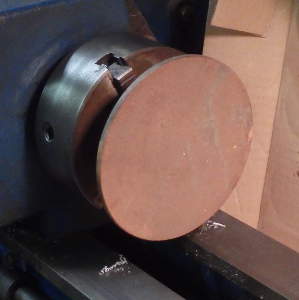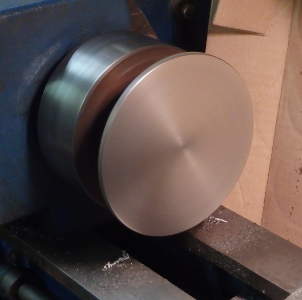
New Blog for 2014
|
||||||||||||||||||||||||
January 1, 2014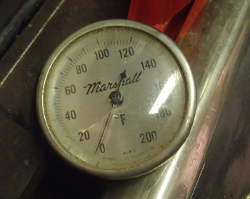 Well,
another year begins. But, damn, is it cold! I
don't think we'll be doing much in the shop until the
temperatures get up above freezing for a while... The
photo to the right is the thermometer we put in the
Heidelberg as it warms up. Can't print below 50 degrees
and on this day, it took nearly 4 hours to bring the press
up to temperature so that we could print the annual run of
Fire Company Budget Ballots for our friend Chris... Well,
another year begins. But, damn, is it cold! I
don't think we'll be doing much in the shop until the
temperatures get up above freezing for a while... The
photo to the right is the thermometer we put in the
Heidelberg as it warms up. Can't print below 50 degrees
and on this day, it took nearly 4 hours to bring the press
up to temperature so that we could print the annual run of
Fire Company Budget Ballots for our friend Chris...Meanwhile, life goes on.... Staying warm at home, making plans for the new Restoration Workshop and the New Barn/Print Shop we're planning on building here on our own property - just across the road from the farm where the shop has been since 1986... John Reid in Delaware is selling his house and moving - and is looking for some enterprising young printer to take over his 8x12 C&P, type and other letterpress equipment. See listing 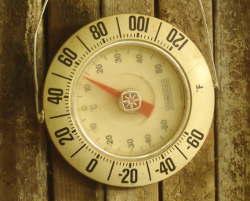 January 10 - All of a sudden, a
one day heat wave! January 10 - All of a sudden, a
one day heat wave!A winter surprise - one day of 56 degree warmth - and humidity. The warmth was quite welcome after weeks of near-zero temperatures, but when this sudden warm, moist air hit the cold, exposed steel of the machines in the shop, the moisture condensed on the cold steel and left everything dripping as though it had rained inside... As the water evaporated, it left behind many unprotected machines with a light coating of surface rust. Butcher Block wax on the imposing table, paper cutter bed and some of the bare steel ink disks protected those surfaces, but otherwise, it was time to go around the shop with a Scotch Brite pad and spray bottle of WD-40 to clean and protect the steel and remove that unsightly powdery surface rust. Next day, the temperature dropped back down into the teens again... January 30 - Temperature is still too low to do much in the shop, but it did rise up into the 20's today. Spring can't be far behind... February 1 Stumbled on a neat online article about one of our students - Joseph Rose of Blackheart Letterpress was featured in this GEEKADELPHIA interview in 2012. His 10x15, btw, was the first big press we actually rescued. It came, many years ago from a print shop - Albion Printing - in Stockton, NJ. It was literally loaded up on the truck and on its way to the scrap yard when I bribed/convinced the scrapper to bring it to my barn instead. But, before he unloaded it, he quadrupled the agreed-upon price for this service. No worries; it was a press to be rescued, and worth the cost. Then this old press sat in a corner of the storage area of the shop for nearly ten years before we brought it into the repair shop, cleaned it up really well, added a new feed board and new set of rollers and put it back into operation. It was supposed to go to Megan in Australia, but exporting a press proved more difficult than we could arrange, so we sent back her deposit and the press stayed here... until Joseph talked me out of it. Now, it's doing some fine work at Black Heart Letterpress. March 18-20  Just in case you might have
thought that nothing was happening at the Excelsior Press,
we have been doing some printing. Aside from a bunch of
job work being done on the Heidelberg (which has its own
insulated and relatively warm room), there was also some
activity back in the colder part of the shop - in the hand
press room... Just in case you might have
thought that nothing was happening at the Excelsior Press,
we have been doing some printing. Aside from a bunch of
job work being done on the Heidelberg (which has its own
insulated and relatively warm room), there was also some
activity back in the colder part of the shop - in the hand
press room...It was still cold outside, so printing on the C&P required 2 propane heaters next to the press, pre-heating the ink disk and a big fat "ink candle" beneath the disk to keep it warm during the press run. But Jason braved the cold and produced this very nice wedding invitation suite on the 10x15 C&P using photo-polymer plates and our Richlite plate base. March 24 Cousin G�ran in Sweden came up with more news of past printers from the Runfeldt Family. Apparently, my great-uncle Gottfried - brother of my Grandfather Anders - was a printer for the Methodist Mission in Africa. An announcement of his death (August, 1910) reports that "He was a printer, and was at work at the mission press only a short time before his death" (click image below to see it full sized) 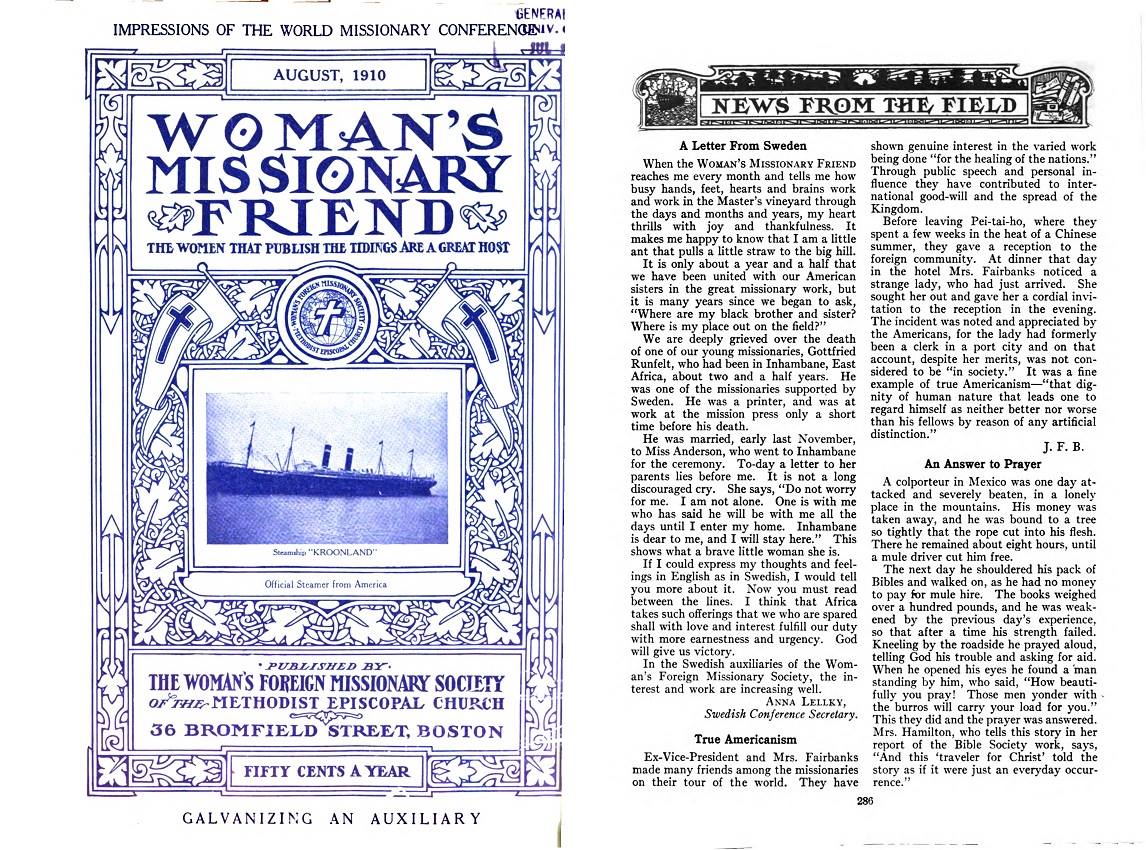 Kelsey Company was shipping presses to missionaries around the world by 1910. I wonder if my great-uncle was printing on a Kelsey press?? Nine years later, Gottfried's brother Anders was a farmer in Bergen County, New Jersey (USA) and my father - Andrew Theodore Runfeldt - was born. Dad was the third of six of the first generation Swedish-American Runfeldts. Thirty years after that, I was born in the U.S. and twelve years later began my adventures in printing... I'd heard that my grandfather had a brother who was a missionary but it wasn't until I was in my sixties that I learned some details of Gottfried Runfeldt's life - and that he was a Printing Missionary! More on the Runfeldt / Printer Swedish Connection April 8 - Melissa's Letterpress Studio 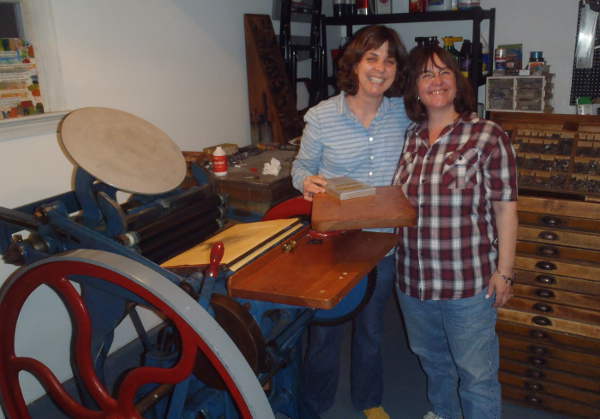 Melissa had come to us a few years ago to
learn how to use her 6x10 Kelsey. But then, it broke. And,
at about the same time, she came upon an early Series
10x15 C&P and asked me if it was a good move to get a
10x15 to use for printing wedding invitations, which is
her focus. She brought the Kelsey to me for repair and
enticed me to come visit her studio to check out the 10x15
she had purchased and had begun using. The impression
throw-off didn't work and pumping the treadle was
difficult, so her daughter would pump the treadle while
she fed the sheets - a clumsy approach, to say the least.
After looking the press over, it was clear that the
problem was clogged oil holes and limited lubrication. Melissa had come to us a few years ago to
learn how to use her 6x10 Kelsey. But then, it broke. And,
at about the same time, she came upon an early Series
10x15 C&P and asked me if it was a good move to get a
10x15 to use for printing wedding invitations, which is
her focus. She brought the Kelsey to me for repair and
enticed me to come visit her studio to check out the 10x15
she had purchased and had begun using. The impression
throw-off didn't work and pumping the treadle was
difficult, so her daughter would pump the treadle while
she fed the sheets - a clumsy approach, to say the least.
After looking the press over, it was clear that the
problem was clogged oil holes and limited lubrication. The first step was to clean the oil holes and lubricate the press as it really needed. We found oil holes that Melissa didn't even know existed; cleaned and oiled them and made the press run quite a bit easier. That helped a lot with both the impression throw-off and the effort required to "kick the treadle". Now the press is running as it should and Melissa is able to kick the treadle and feed the press herself - a relief for her daughter and Melissa both... See Melissa's new website at http://www.hollyandmelissa.com/thepress/ The photo is of Melissa and my lovely and patient wife, Cathy who has put up with my obsession with letterpress since we first met and accompanied me on this service call... 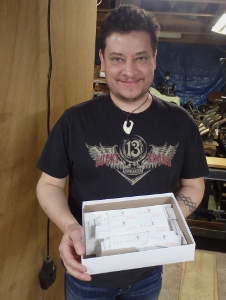 April 14 - Saint Films business cards April 14 - Saint Films business cardsCharley is a film maker. he does commercial work and documentaries. His company is Saint Films and he wanted some deep-impression letterpress cards - on 600 gsm Letra - and he wanted to document their production. That sounded like fun to me, so we ordered some 600gsm Brite White Lettra and some metal photo-engravings of his design and began the production - 3/1 ... which means 3 colors (in very tight register) on the front and one color (transparent white) on the back. He initially wanted the backs to be simply debossed - striking blind, with no ink. But, when saw the effect of transparent white ink instead of dry debossing, he loved the suggestion and that's what we did. June 21 - Moving George's 8x12 - "Old Rusty" 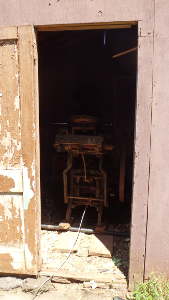 George had gotten this press many years
ago - with plans to do numbering for a local printer...
But that never happened, and the press sat in this little
shed for many years... and got very rusty. He'd
contacted me a few years ago to come and get it, but with
a barn already stuffed to the rafters with presses, I just
had no room for another... But now that we have our own
home - and a large garage to work in, when he called
again, I agreed to come and get it. George had gotten this press many years
ago - with plans to do numbering for a local printer...
But that never happened, and the press sat in this little
shed for many years... and got very rusty. He'd
contacted me a few years ago to come and get it, but with
a barn already stuffed to the rafters with presses, I just
had no room for another... But now that we have our own
home - and a large garage to work in, when he called
again, I agreed to come and get it. 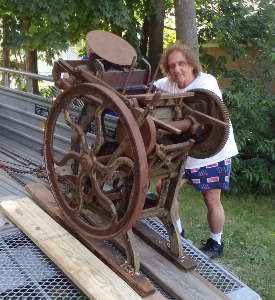 But it had sat in this
little shed for so long, that everything had rusted fast -
the flywheel and ink disk would not even turn. It was in
rough, rusty shape... But it had sat in this
little shed for so long, that everything had rusted fast -
the flywheel and ink disk would not even turn. It was in
rough, rusty shape... But the good news is that after a week or so of intense cleaning and oiling, I was able to first get the ink disk to rotate. Then I worked on the main oil holes - cleaning out the debris and rust, filling the cleaned oil holes with first WD-40, then 3-in-one oil, and finally with straight 30-weight motor oil. By the time I was done with the oiling, this rusty old press was moving smoothly and easily - as well as any 8x12 I'd ever worked on. I was beginning to get pretty excited about this rusty old press. It would work again... ... and then I got a phone call.... "Newsies" is back and going on the road... 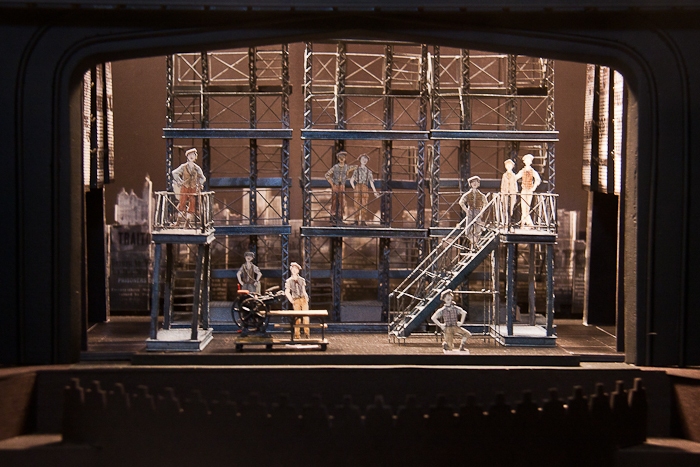 The call I got was from the set
director of the Broadway musical "Newsies". Newsies
was wrapping up their 3 years on Broadway and preparing to
go on the road - and they needed another Chandler &
Price Printing Press to be used in the show. The call I got was from the set
director of the Broadway musical "Newsies". Newsies
was wrapping up their 3 years on Broadway and preparing to
go on the road - and they needed another Chandler &
Price Printing Press to be used in the show.In the musical, young newspaper boys - aka "Newsies" decide to go on strike against Joseph Pulitzer for fair treatment. In order to get public support, they decide to publish their own newspaper - using one of Mr. Pulitzer's old, unused presses - without, of course, his knowledge. When the show first debued at the Paper Mill Playhouse in Millburn, NJ, they had some problems with the press they had purchased. It had no treadle and would not move smoothly. I was called in to fabricate and install a treadle and get the press to work as it should. And it has. For the past 3 1/2 years, that old C&P has been pumped and hand-fed on the stage nearly every night... And now, when they needed another press, they remembered me, gave me a call and I was able to tell them that yes, I had a press in the shop right now that I could prepare for them... So, George's "Old Rusty" will soon be in the hands of the prop house - all set up and ready to use as Newsies makes its way around the country. Talk about some neat "Letterpress Rescue".... ;) June 26 - Sigwalt disk & rollers When Donna brought me her little Sigwalt, it was in need of a set of rollers and some general clean up. To resurface the ink disk, I put it on the lathe and went to work. Here are the before and after shots of the rusty disk made shiny again...
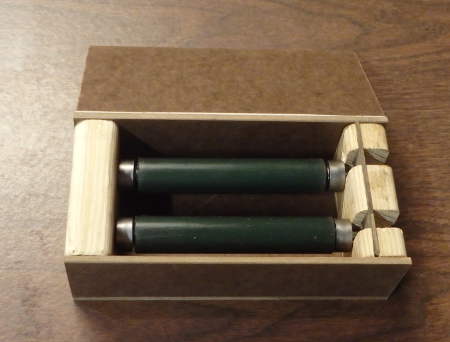 and, of course,
the rollers.... and, of course,
the rollers.... We chose a softer rubber for this little press. The standard 30 durometer rollers don't have much give in a 3/4" roller, so we cast these using 20-durometer - they are just about as soft and resiliant - and as tacky - as the traditional "Compositon" rollers - only these will outlast gum composition by many, many years.... and rodents will not find them as tasty as the gum-arabic, "gummy-bear" composition.... And of course, we made a cute little box to keep them in as well.... July 21 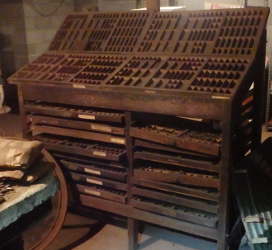 Doug Neice worked for many years at
the Hunterdon County Democrat. He was there when
it was a letterpress shop. And, when they moved from hot
type to photo type and from letterpress to offset. When
they stopped using this equipment, he took some of the
type and a press that was used at the newspaper and stored
it in his garage and basement. Doug Neice worked for many years at
the Hunterdon County Democrat. He was there when
it was a letterpress shop. And, when they moved from hot
type to photo type and from letterpress to offset. When
they stopped using this equipment, he took some of the
type and a press that was used at the newspaper and stored
it in his garage and basement. Doug passed away recently - with a press in the garage and the basement. No, not two presses, parts for one press- a 10x15 C&P - totally disassembled. It will be an interesting project to put it back together again after sitting in pieces for perhaps 20 years or more.... There is also this City Stand, which was used for many years in the typesetting department of the 250 year-old newspaper. I wonder when this City Stand was first put into service in their composing room... Soon, we will be cleaning it and preparing it for its future... A good museum piece. Authentic. With a known history... August 4 - Three men and a press (two presses) 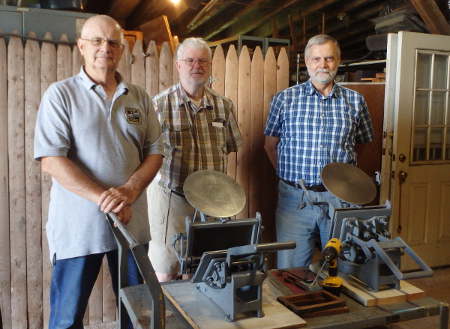 The .918
Club of Lancaster, PA has quite a few presses
- including a 3/4-scale wooden Common Press. But they also
have some Pilots and Excelsiors. The .918
Club of Lancaster, PA has quite a few presses
- including a 3/4-scale wooden Common Press. But they also
have some Pilots and Excelsiors. These two 6x10 Excelsiors are the ones used for demonstrations - where the kids get to print their own name - and Boy Scouts can earn their Printing Merit Badge. But they didn't work quite right, so Ken, Paul and Frank came to visit with these two presses - to get them set up to print as they should. We had to level the platens, replace the springs holding the rollers in place and remove residual paint from the insides of the roller saddles so that the rollers would roll smoothly and stop jumping out of the saddles. 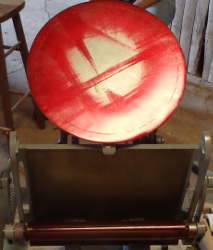 One of
them had a disk that had been badly turned down at some
time in the past - possibly to remove rust, but the
turning had not been perfect. This disk will have to be
refaced, or, more likely, replaced. The low center means
that ink will not be carried there, so less ink will reach
the center of the form. It could be used, but not for all
designs. One of
them had a disk that had been badly turned down at some
time in the past - possibly to remove rust, but the
turning had not been perfect. This disk will have to be
refaced, or, more likely, replaced. The low center means
that ink will not be carried there, so less ink will reach
the center of the form. It could be used, but not for all
designs.Since the .918 Club is based in Lancaster, I suggested that they take it over to Mr. King at Cattail Foundry. He may be able to cast them a replacement disk. Of course, then it will have to be milled and machined, and then hardened, but these days, when you need Kelsey parts, sometimes the only way to get them is to make them... Aug 6 - Ben Franklin's Press 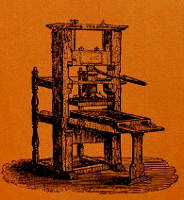 Got another phone call from the prop guy from
Newsies.... They're doing another musical - "Amazing
Grace". There are scenes that take place in a London
Printing Office around 1750. They need another press.... a
Wooden Common Press as would have been used in London (or
Philadelphia or Boston) in 1750. Since few of these still
exist, and the only reproduction found available was
priced at $25k, they asked me to make one for them... Got another phone call from the prop guy from
Newsies.... They're doing another musical - "Amazing
Grace". There are scenes that take place in a London
Printing Office around 1750. They need another press.... a
Wooden Common Press as would have been used in London (or
Philadelphia or Boston) in 1750. Since few of these still
exist, and the only reproduction found available was
priced at $25k, they asked me to make one for them... So now, it looks like we'll finally be able to do something I have dreamed of for fifty years... We will be manufacturing a reproduction Wooden Common Press - just like the one Ben Franklin used... Very exciting - and somewhat daunting project, but well worth the effort and the time to do it... BUT - The show opens in October, so we're gonna be busy as heck for the next 5 weeks. Watch here (and here) for updates on this project. August 21 Studying this Wooden Common Press, and the history of printing and presses prior to 1850 has had me thinking about a really short, easy history of letterpress printing and typesetting. Here it goes. How's this for brevity? A Very Brief and Concise History of Printing Technologies used since Gutenberg first began casting movable type.
That's it. Not the most complete history, but one that is both accurate in general and easy to absorb. Of course, between these 4 points of time for each aspect of printing, there were a wide range of evolutionary changes. The hot-metal, line-casting Intertype, for example, evolved into a film setting machine. Same old hot-metal-casting hardware, but instead of melting lead into aligned matrices, the lines of film negatives were exposed to photo-graphic paper. Must also note that large, high-speed, custom-designed and custom-built high-speed cylinder presses were used to print big-city newspaper as early as the 1820's. Job shops and small-town local newspapers, however, could not afford such equipment. And, although photo-typesetting was used in major newspaper in the 1950's, it wasn't until the 1980's that similarly-capable equipment was affordable to the small job shop or local newspaper. And, although the Heidelberg Windmill first appeared in 1926, it was relatively expensive and many shops continued to use their old, reliable and absolutely simple hand-fed C&Ps until using them became almost totally uncompetitive for most work by the mid-1960's. By the 1980's many of these old C&Ps had been scrapped. That's why it's so important that we save the ones we have left. As we all know (or should know), a 10x15 C&P is an ideal press for doing all sorts of printing, and many have come back into service during the past 20 years and even at the absurdly high prices some are selling for, they are certainly paying their way! (I should move this post to a page of it's own - and will, when I get a Round Tuit, but I'll post a link to if from here.) August 24 - 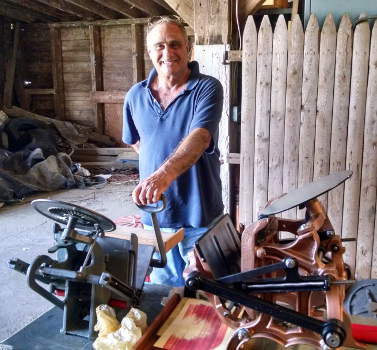 Louis
brought down two more of his presses to be set-up and
prepared for printing. Louis
brought down two more of his presses to be set-up and
prepared for printing. One is a 6x10 Kelsey Victor Style Excelsior, the other is a beautifully restored Early Series Chandler & Price Pilot. Both presses are fully assembled, with new rollers. Only the feed boards need to be attached. We are adjusting the platen and the rollers and making test prints on both of these presses. We also invite any interested buyers to come to the shop in Frenchtown and actually use them before committing to buy. Either way, their new owners will have no doubt about their suitability for printing. We have had numerous inquiries for presses of this size, so alerts are being emailed to prospective buyers. But until someone commits to actually buy each of these presses, they are listed as "available for sale" Prices for these presses will be $2500 for the 6 1/2x10 C&P note 9/10: Lou has agreed to drop the prices for quick sale to help finance his move to a new shop. Make an offer on either of these presses and you can plan to start printing as soon as you come to the farm here in Frenchtown, NJ to pick up your press, or when it arrives at your doorstep... note 9/17: The 6x10 Kelsey is sold, however another Kelsey - a beautifully restored Early Series 1920's 3x5, will be available very soon for $675. 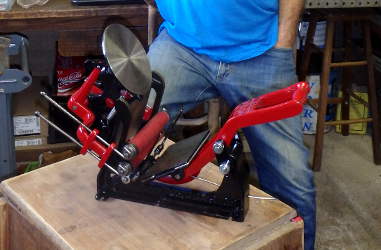 We have not printed with this press yet, but we have worked the action and I must say, it has the smoothest action of any Kelsey I have ever used. When the rollers cross from the chase bed to the ink disk, there is almost no "bump" as on most Kelseys. The rollers are oversized, and that may be the reason. In any case, oversized rollers will carry more ink to the form. We'll print with this press soon and will guarantee satisfaction to the eventual owner of this really nice old Kelsey Excelsior. I'm tempted to keep it myself, since this is the model I used when I was twelve years old, and it was the "Excelsior" on the side of my press that influenced the naming of The Excelsior Press when I was a boy. September 17 - Deadline met - "Last Pull" The Wooden Common Press is completed and shipped. 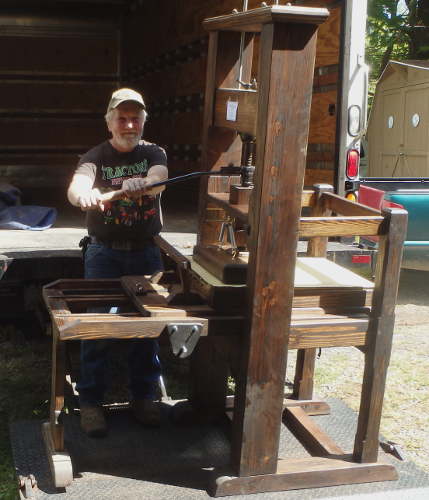 It was a whirlwind few months,
building this replica Wooden Common Press which will be
used as a prop in the new musical "Amazing Grace"
- opening on Oct 9 in Chicago. It was a whirlwind few months,
building this replica Wooden Common Press which will be
used as a prop in the new musical "Amazing Grace"
- opening on Oct 9 in Chicago. But it's over now. The press is completed and is beautiful and is on its way to Chicago as I type these words... The photo shows the "Last Pull" for me on this press, which, I must admit has found its way into my heart. And now it's gone - off to do what it was meant to do - convince the audience that this press was made in the 1700's and looks "just right" for the scenes in a London Printing office around 1750. It will do it's job. It looks exactly like the wooden common press that would have been used there then. It was built using the plans drawn up by the Smithsonian Institution when they replicated the press in their collection - reputed to have been the press Ben Franklin worked on as an apprentice in London in 1726. And it works. When the Rounce is turned, the bed moves beneath the platen. When the lever is pulled, the platen is pressed against the form. When the lever is returned to "the far cheek", the platen is raised enough to clear the form. When the bed is cranked back out, the tympan can be raised and the printed sheet removed. The bed cranks in and out, the platen goes up and down when the handle is pulled. It works. And, it is beautiful - furniture grade construction - all held together by mortises and tenons and pegs - only the head bolts and spindle and rounce shaft are steel. The Doglas Fir has been stained as Dark Walnut, then shellaced and oiled and polished (and then dusted with more sawdust before this photo was taken...) and I miss it already. There is soooo much more I wanted to do to perfect this wonderful wooden machine, but the deadline had to be met, and, after all - as my client reminded me frequently - "It's only a prop.". Well, it's the best damned prop I could whip up on short notice, and we did it. We did cut many corners and stray a bit from the old design - but only in raw materials (Douglas Fir instead of seasoned Elm and Oak) and technical and mechanical parts - and only to get the job done on time. Cost was not spared. Time could not be spared. It had to be ready to ship on 9/18 - and it was - as the photo above documents clearly. "The Last Pull" - and I miss it already. See the full report on making this press. October - was very, very busy... catch up later November, 2014 Interesting "Survivors' Library" - pdf files on various classic printing technology - Wednesday, December 23, 2014 - Christmas Eve 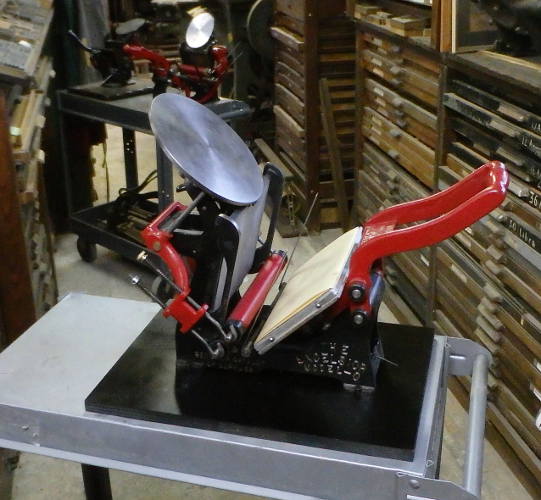 Andrew wanted to get his wife Julie a small press for Christmas, so we prepared this fully restored 5x8 Kelsey Excelsior for her. The press had been fully disassembled, sand blasted and painted, reassembled with new shafts, springs and rollers and adjusted to make a perfect print "right out of the box". But since this will be her first time printing, and she can't get here for personalized training, we used it to shoot a series of brief instructional videos to illustrate the procedures she will follow when gets her press. This first photo is just the press, the videos can be seen on YouTube at https://www.youtube.com/user/NoDeadlines (Look for the "Julie's Press" series of 6 short clips.) OR - see our new Youtube Videos page for more info - and more videos |
||||||||||||||||||||||||
Excelsior Press Fundraising/Presses, parts & supplies Page |

